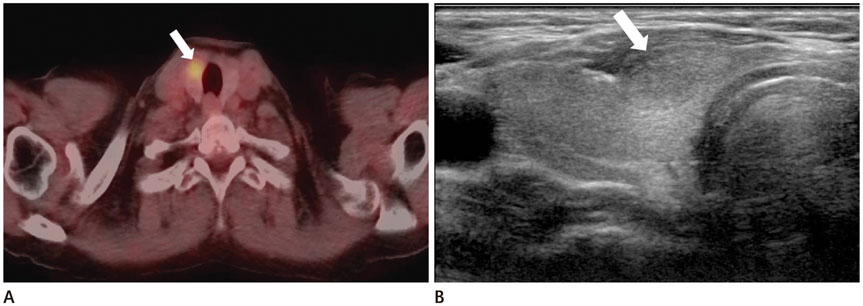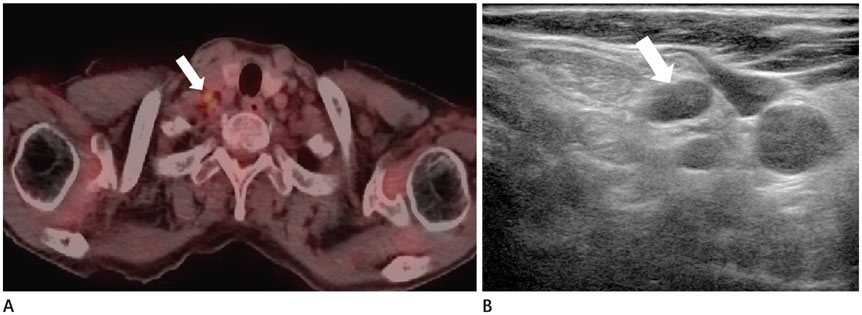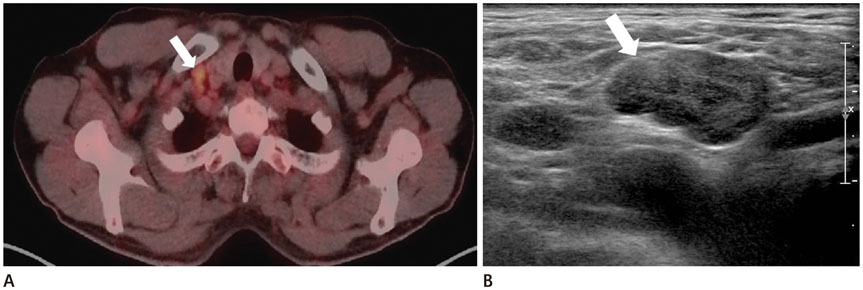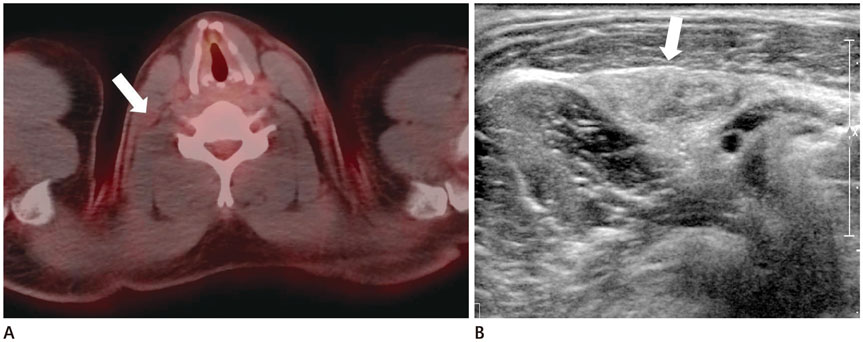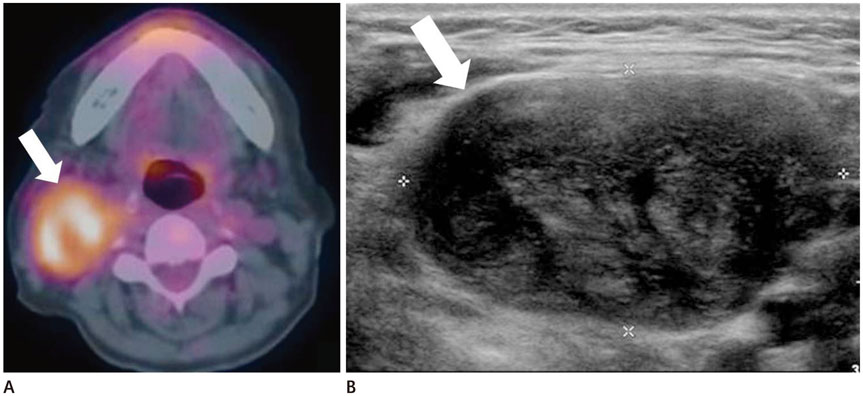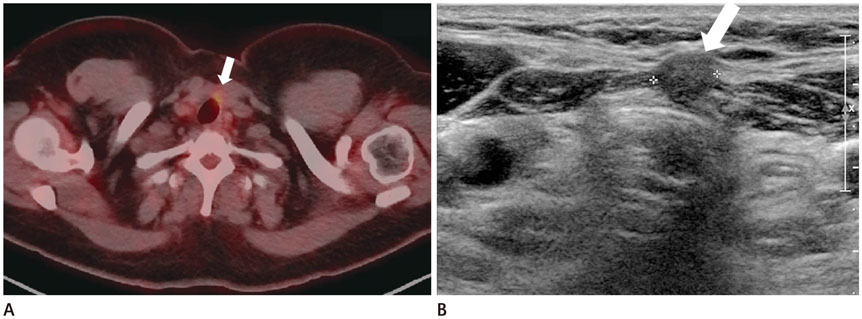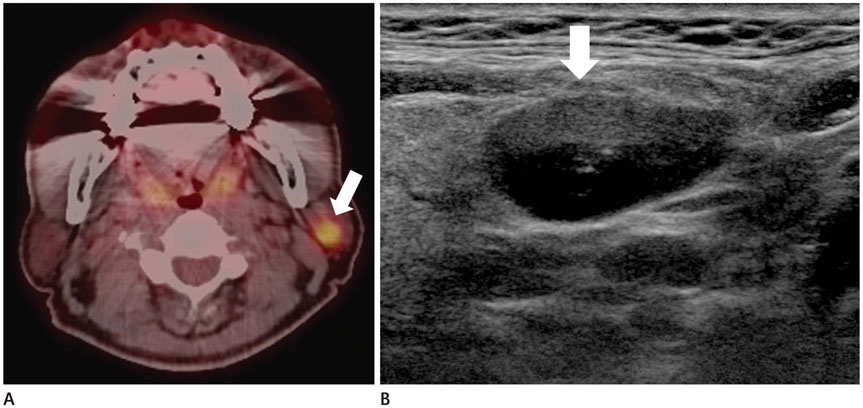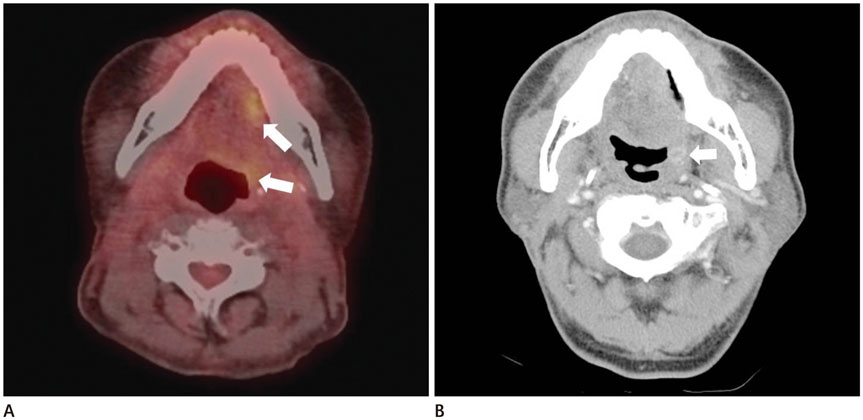J Korean Soc Radiol.
2017 Feb;76(2):126-137. 10.3348/jksr.2017.76.2.126.
Benign Thyroid and Neck Lesions Mimicking Malignancy with False Positive Findings on Positron Emission Tomography-Computed Tomography
- Affiliations
-
- 1Department of Radiology, Soonchunhyang University Cheonan Hospital, Cheonan, Korea. taloo@hanmail.net
- 2Department of Nuclear Medicine, Soonchunhyang University Cheonan Hospital, Cheonan, Korea.
- 3Department of Surgery, Younsei Angelot Women's Clinic, Cheonan, Korea.
- KMID: 2367860
- DOI: http://doi.org/10.3348/jksr.2017.76.2.126
Abstract
- The increasing use of positron emission tomography-computed tomography (PET/CT) has led to the frequent detection of incidental thyroid and neck lesions with increased ¹â¸F-deoxyglucose (FDG) uptake. Although lesions with increased FDG uptake are commonly assumed to be malignant, benign lesions may also exhibit increased uptake. The purpose of this pictorial essay is to demonstrate that benign thyroid and neck lesions can produce false-positive findings on PET/CT, and to identify various difficulties in interpretation. It is crucial to be aware that differentiating between benign and malignant lesions is difficult in a considerable proportion of cases, when relying only on PET/CT findings. Correlation of PET/CT findings with additional imaging modalities is essential to avoid misdiagnosis.
MeSH Terms
Figure
Reference
-
1. Bae JS, Chae BJ, Park WC, Kim JS, Kim SH, Jung SS, et al. Incidental thyroid lesions detected by FDG-PET/CT: prevalence and risk of thyroid cancer. World J Surg Oncol. 2009; 7:63.2. Lee KH, Shin JH, Han BK, Ko EY, Ko ES, Hahn SY, et al. Incidental thyroid lesions detected on 18F-fluorodeoxyglucose positron emission tomography/CT in patients with non-thyroidal cancer: clinical implications and the value of ultrasound. J Korean Soc Radiol. 2014; 71:111–119.3. Purohit BS, Ailianou A, Dulguerov N, Becker CD, Ratib O, Becker M. FDG-PET/CT pitfalls in oncological head and neck imaging. Insights Imaging. 2014; 5:585–602.4. Fukui MB, Blodgett TM, Snyderman CH, Johnson JJ, Myers EN, Townsend DW, et al. Combined PET-CT in the head and neck: part 2. Diagnostic uses and pitfalls of oncologic imaging. Radiographics. 2005; 25:913–930.5. Solbiati L, Osti V, Cova L, Tonolini M. Ultrasound of thyroid, parathyroid glands and neck lymph nodes. Eur Radiol. 2001; 11:2411–2424.6. Yeo SH, Lee SK, Hwang I, Ahn EJ. Subacute thyroiditis presenting as a focal lesion on [18F] fluorodeoxyglucose whole-body positron-emission tomography/CT. AJNR Am J Neuroradiol. 2011; 32:E58–E60.7. Karantanis D, Bogsrud TV, Wiseman GA, Mullan BP, Subramaniam RM, Nathan MA, et al. Clinical significance of diffusely increased 18F-FDG uptake in the thyroid gland. J Nucl Med. 2007; 48:896–901.8. Liu Y, Ghesani NV, Zuckier LS. Physiology and pathophysiology of incidental findings detected on FDG-PET scintigraphy. Semin Nucl Med. 2010; 40:294–315.9. Skoura E, Zumla A, Bomanji J. Imaging in tuberculosis. Int J Infect Dis. 2015; 32:87–93.10. Vorster M, Sathekge MM, Bomanji J. Advances in imaging of tuberculosis: the role of 18F-FDG PET and PET/CT. Curr Opin Pulm Med. 2014; 20:287–293.11. Nair AV, Sandya CJ, Shagos GS, Anirudh S, Rajamma BM, Ramachandran PV, et al. Role of dual time fluorodeoxyglucose (FDG) positron emission tomography-computed tomography in identifying co-existing inflammatory and malignant disease: Who holds it (FDG) longer? Indian J Nucl Med. 2015; 30:139–141.12. Jacene HA, Stearns V, Wahl RL. Lymphadenopathy resulting from acute hepatitis C infection mimicking metastatic breast carcinoma on FDG PET/CT. Clin Nucl Med. 2006; 31:379–381.13. Payabvash S, Meric K, Cayci Z. Differentiation of benign from malignant cervical lymph nodes in patients with head and neck cancer using PET/CT imaging. Clin Imaging. 2016; 40:101–105.14. Yabuuchi H, Kuroiwa T, Fukuya T, Tomita K, Hachitanda Y. Traumatic neuroma and recurrent lymphadenopathy after neck dissection: comparison of radiologic features. Radiology. 2004; 233:523–529.15. Kim EY, Kang DK, Kim TH, Kim KS, Yim H. Traumatic neuroma in a breast cancer patient after modified radical mastectomy: a case report. J Korean Soc Radiol. 2011; 64:515–518.16. Liu Y. Orthopedic surgery-related benign uptake on FDG-PET: case examples and pitfalls. Ann Nucl Med. 2009; 23:701–708.17. Beaulieu S, Rubin B, Djang D, Conrad E, Turcotte E, Eary JF. Positron emission tomography of schwannomas: emphasizing its potential in preoperative planning. AJR Am J Roentgenol. 2004; 182:971–974.18. Anil G, Tan TY. Imaging characteristics of schwannoma of the cervical sympathetic chain: a review of 12 cases. AJNR Am J Neuroradiol. 2010; 31:1408–1412.19. Kim HR, Hong HS, Lee EH, Lee MH, Park JM, Kwak JJ, et al. Ultrasonographic findings of foreign-body granulomas after endoscopic thyroidectomy via an axillo-breast approach. J Korean Soc Radiol. 2012; 66:507–517.20. Miyake KK, Nakamoto Y, Mikami Y, Ishizu K, Saga T, Higashi T, et al. F-18 FDG PET of foreign body granuloma: pathologic correlation with imaging features in 3 cases. Clin Nucl Med. 2010; 35:853–857.21. Hadiprodjo D, Ryan T, Truong MT, Mercier G, Subramaniam RM. Parotid gland tumors: preliminary data for the value of FDG PET/CT diagnostic parameters. AJR Am J Roentgenol. 2012; 198:W185–W190.22. Uchida Y, Minoshima S, Kawata T, Motoori K, Nakano K, Kazama T, et al. Diagnostic value of FDG PET and salivary gland scintigraphy for parotid tumors. Clin Nucl Med. 2005; 30:170–176.23. Thoeny HC, De Keyzer F, King AD. Diffusion-weighted MR imaging in the head and neck. Radiology. 2012; 263:19–32.24. Ohba K, Sasaki S, Oki Y, Nishizawa S, Matsushita A, Yoshino A, et al. Factors associated with fluorine-18-fluorodeoxyglucose uptake in benign thyroid nodules. Endocr J. 2013; 60:985–990.25. Zochodne DW, Nguyen C, Sharkey KA. Accumulation and degranulation of mast cells in experimental neuromas. Neurosci Lett. 1994; 182:3–6.26. Horiuchi M, Yasuda S, Shohtsu A, Ide M. Four cases of Warthin’s tumor of the parotid gland detected with FDG PET. Ann Nucl Med. 1998; 12:47–50.
- Full Text Links
- Actions
-
Cited
- CITED
-
- Close
- Share
- Similar articles
-
- Transient ¹â¸F-Fluorodeoxyglucose Activity on PET/CT of Herniation Pit in Thyroid Cancer Patient: A Case Report
- Clinical Etiology of Hypermetabolic Pelvic Lesions in Postoperative Positron Emission Tomography/Computed Tomography for Patients With Rectal and Sigmoid Cancer
- False Positive and False Negative FDG-PET Scans in Various Thoracic Diseases
- 18F-2-Deoxy-2-Fluoro-D-Glucose Positron Emission Tomography: Computed Tomography for Preoperative Staging in Gastric Cancer Patients
- Non-Malignant 18F-FDG Uptake in the Thorax by Positron Emission Tomography Computed Tomography Fusion Imaging

